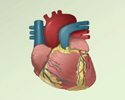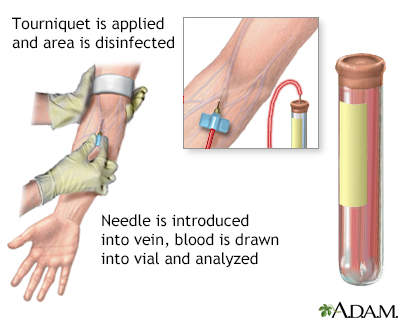Lipid profile test
Lipids are fatty, wax-like substances found in the body. Your body needs lipids for proper body functions, growth, and energy. Two important types of lipids found in the blood are cholesterol and triglycerides. High levels of lipids in your blood may clog your arteries and increase your risk of heart disease and stroke.
Triglycerides
The triglyceride level is a blood test to measure the amount of triglycerides in your blood. Triglycerides are a type of fat. Your body makes some t...

Heart disease
Coronary heart disease is a narrowing of the blood vessels that supply blood and oxygen to the heart. Coronary heart disease (CHD) is also called co...

Stroke
A stroke occurs when blood flow to a part of the brain stops. A stroke is sometimes called a "brain attack. " If blood flow is cut off for longer th...

A lipid profile is a blood test to measure different types of lipids:
- Total cholesterol: This is the measure of all the cholesterol in your blood.
Total cholesterol
Total cholesterol is a blood test to measure all types of cholesterol in your blood. Cholesterol is a fatty, wax-like substance found in all parts o...
 ImageRead Article Now Book Mark Article
ImageRead Article Now Book Mark Article - High-density lipoprotein cholesterol (HDL [good] cholesterol): HDL helps remove LDL from your blood.
HDL [good] cholesterol
The high-density lipoprotein (HDL) test is a blood test to measure the amount of HDL cholesterol in your blood. HDL is a type of fat (lipid) in your...
 ImageRead Article Now Book Mark Article
ImageRead Article Now Book Mark Article - Low-density lipoprotein cholesterol (LDL [bad] cholesterol): LDL can build up in your blood vessels and increase your heart disease risk.
LDL [bad] cholesterol
The low-density lipoprotein (LDL) test is a blood test to measure the amount of LDL cholesterol in your blood. LDL is a type of fat (lipid) in your ...
 ImageRead Article Now Book Mark Article
ImageRead Article Now Book Mark Article - Very low-density lipoprotein cholesterol (VLDL cholesterol): VLDL moves triglycerides from your liver to other cells. VLDL can also build up in your blood vessels.
VLDL cholesterol
VLDL stands for very low density lipoprotein. Lipoproteins are made up of cholesterol, triglycerides, and proteins. They move cholesterol, triglyce...
 ImageRead Article Now Book Mark Article
ImageRead Article Now Book Mark Article - Triglycerides: Your body makes some triglycerides. Triglycerides also come from the food you eat. Extra calories are turned into triglycerides and stored in fat cells for later use.
How the Test is Performed
A blood sample is needed. Most of the time, blood is drawn from a vein located on the inside of the elbow or the back of the hand.
Blood is drawn from a vein
Venipuncture is the collection of blood from a vein. It is most often done for laboratory testing.

How to Prepare for the Test
You should not eat for 9 to 12 hours before the test. If you don’t fast, only values for total cholesterol and HDL may be useful.
Alcohol and some medicines can interfere with blood test results.
- Make sure your health care provider knows what medicines you take, including over-the-counter medicines and supplements.
- Your provider will tell you if you need to stop taking any medicines before you have this test.
- Do not stop or change your medicines without talking to your provider first.
How the Test will Feel
You may feel slight pain or a sting when the needle is inserted. You may also feel some throbbing at the site after the blood is drawn.
Why the Test is Performed
A lipid profile test helps you and your provider understand your risk for heart disease.
You also may have this test to see how well you are responding to medicines to help lower your cholesterol.
Normal Results
The most common ideal results for these levels are:
- Total cholesterol below 200 milligrams per deciliter (mg/dL) or 5.18 millimoles per liter (mmol/L).
- HDL from 40 to 60 mg/dL (1.04 to 1.55 mmol/L), though even higher is better.
- LDL generally below 100 mg/dL (2.59 mmol/L). For people with heart or other vascular disease, it should be below 70 mg/dL (1.81mmol/L).
- VLDL 2 to 30 mg/dL (0.05 to 0.78 mmol/L).
- Triglycerides below 150 mg/dL (3.88 mmol/L) for adults and lower than 90 mg/dL (2.33 mmol/L) for 10 to 19 year olds.
Normal value ranges may vary slightly among different laboratories. Talk to your provider about the meaning of your specific test results.
What Abnormal Results Mean
If your lipid profile testing is abnormal, your provider may recommend lifestyle changes, cholesterol-lowering medicine, or continued monitoring of your blood lipid levels.
Risks
There is little risk involved with having your blood taken. Veins and arteries vary in size from one person to another and from one side of the body to the other. Taking blood from some people may be more difficult than from others.
Other risks associated with having blood drawn are slight, but may include:
- Fainting or feeling lightheaded
Fainting
Fainting is a brief loss of consciousness due to a drop in blood flow to the brain. The episode most often lasts less than a couple of minutes and y...
Read Article Now Book Mark Article - Multiple punctures to locate veins
- Hematoma (blood buildup under the skin)
Hematoma
Bleeding into the skin can occur from broken blood vessels that form tiny red dots (called petechiae). Blood also can collect under the tissue in la...
 ImageRead Article Now Book Mark Article
ImageRead Article Now Book Mark Article - Excessive bleeding
- Infection (a slight risk any time the skin is broken)
Considerations
Certain medicines, pregnancy, infection, and some medical conditions can affect test results.
Reviewed By
Michael A. Chen, MD, PhD, Associate Professor of Medicine, Division of Cardiology, Harborview Medical Center, University of Washington Medical School, Seattle, WA. Also reviewed by David C. Dugdale, MD, Medical Director, Brenda Conaway, Editorial Director, and the A.D.A.M. Editorial team.
Bredefeld CL, Lau R, Hussain MM. Lipids and dyslipoproteinemia. In: McPherson RA, Pincus MR, eds. Henry's Clinical Diagnosis and Management by Laboratory Methods. 24th ed. Philadelphia, PA: Elsevier; 2022:chap 18.
Genest J, Mora S, Libby P. Lipoprotein disorders and cardiovascular disease. In: Libby P, Bonow RO, Mann DL, Tomaselli, GF, Bhatt DL, Solomon SD, eds. Braunwald's Heart Disease: A Textbook of Cardiovascular Medicine. 12th ed. Philadelphia, PA: Elsevier; 2022:chap 27.
Marshall WJ, Lapsley M, Day A, Shipman K. Lipids, lipoproteins and cardiovascular disease. In: Marshall WJ, Lapsley M, Day A, Shipman K, eds. Clinical Chemistry. 9th ed. St Louis, MO: Elsevier; 2021:chap 17.
Robinson JG. Disorders of lipid metabolism. In: Goldman L, Cooney KA, eds. Goldman-Cecil Medicine. 27th ed. Philadelphia, PA: Elsevier; 2024:chap 190.




 All rights reserved.
All rights reserved.